1.3 Nigredo - Blackness
The wise man is not surprised by death
he
is always ready to leave.
La Fontaine
This melancholic state is so
powerful
that, according to scientists and doctors,
it can attract
demons to the body,
even to such an extent
that one can get into
mental confusion or get visions.
Agrippa
Nigredo, or blackness, in the alchemical
sense, means putrefaction, decomposition. By the penetration of the
external fire, the inner fire is activated and the matter starts to
putrefy. The body is reduced to its primal matter from which it
originally arose. This process is also called ‘cooking’. The black earth
is closed up in a vessel or flask, and heated.
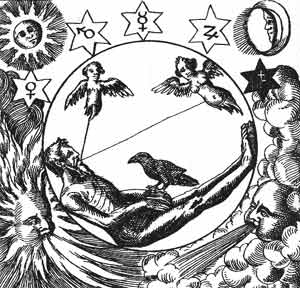
(Basilius Valentinus, Azoth, Paris, 1659)
The Body is to be decomposed, that is one shifts one's awareness to the inner self. The planets are both stages of the process and energies in the body to be transmuted. The Saturn star is black as Saturn reigns over Nigredo. Sun and Moon are the opposites to be united, and fire and air are the elements stimulating the decomposition. The black crow is another symbol for Nigredo. The two birds coming out of the body are the soul and the spirit. One needs to become aware of one's soul and spirit. The circle emphasizes the idea of union or unification.
"Putrefaction is so effective that it destroys
the old nature and form of the rotting bodies; it transmutes them into a
new state of being to give them a totally new fruit. Everything that has
live, dies; everything that is dead putrefies and finds a new life."
(Pernety, 1758)
On the mythological level, nigredo signifies the
difficulties man has to overcome on his journey through the underworld.
Nigredo is sometimes called ‘blacker than the blackest black’. Hercules
had to accomplish twelve, almost impossible, tasks. The pilgrim
traditionally encounters shadows, monsters, demons. In the ancient
mysteries the candidates had to undergo difficult, sometimes painful and
even dangerous initiation tests.
In alchemy, one of the symbols of
nigredo is the ‘decapitation’, and also the ‘raven’s head’ (caput
corvi). Those symbols refer to the dying of the common man, the dying of
his inner chaos and doubt because he is unable to find the truth in
himself. In one of his works, Hercules cleanses the Augias stables. It
is the cleansing of all the impurities in oneself.
(Johann Daniel
Mylius, Philosophia reformata, Frankfurt, 1622)
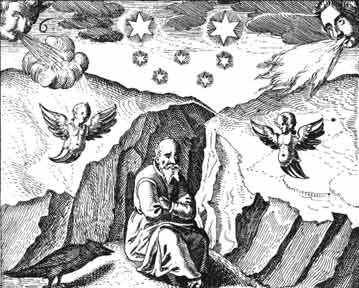
A monk in meditation in an earth crevice, shows that alchemy was in first instance a spiritual practice. The two bird-figures are the soul and spirit to become aware of.
Psychologically, nigredo is a process of directing
oneself to find self-knowledge. A problem is given full attention and
reduced to its core. This is not done so much in an intellectual way,
but especially by feeling the emotions. By really going into to it, one
causes putrefaction, the decomposition of that in which one had been
stuck. The confrontation with the inner reality is often painful, and
can lead to depression. But once in the depth of the darkness, with the
discovery of the seed of the problem, the seed in the ‘prima materia’,
the white light is born (=albedo, whiteness, the next phase). A state of
rest arises. Insight into the problem has been gained, it has been
worked out emotionally, and knowledge arises on how to handle it in a
more positive way and to build a more pure attitude.
Alchemists
talked about unraveling ‘the mixture’(=man with all his complexities) in
order to return to the germ. "That from which a thing has been made in a
natural way, by that same thing it must return to a dissolved state into
its own nature. Everything has to be dissolved and reduced into that
form from which is arose." (Anton Joseph Kirchweger, 1728)
‘Matter’
has to be stripped of its superfluities in order to arrive at the
center, which contains all the power of ‘the mixture’. The seed is the
essence and contains all the essential powers of the body. One has to go
to the center of his problems, to the center of his emotions, to the
center of himself. There is the power of transformation.
Saturn is
the planet that rules nigredo. Saturn as an alchemical symbol is used,
like Mercurius, as a symbol of chaos, the prima materia as rough stone,
and as the philosopher’s stone. These are all symbols for man at the
beginning of the alchemical process. Saturn, with his traditional scythe
and hourglass, is the god of death and putrefaction, from which new life
will arise. The scythe is another tool for penetration, as is the lance
and the sword. Saturn is the philosopher’s lead. He is the god that can
cause melancholy and devilish visions. ‘Melancholia’ is another term for
nigredo. As melancholy can arise when alchemically working on oneself,
the alchemists advised the use of music to lift the soul.
Saturn is
also a god of fertility. Therefore "our black earth is fertile earth",
an alchemical expression to express the transformation of death into new
life, which is also clearly depicted in the thirteenth tarot card. The
putrefaction is a necessary phase to start a new beginning. Life itself
is a cycle of death and birth, ever creating new life, giving man the
opportunity to work on himself and strife to improve his condition.
The alchemists say that nigredo lasts forty days. Forty days has a
symbolic value. Jesus fasted for forty days in the desert. There are
forty days of fasting between Easter and Ascension Day. The Israelites
wandered for forty days in the desert. Saint Antonius spent forty years
in the Sahara desert, being plagued by visions of extreme erotic scenes
and devils.
1.4 The Peacock’s Tail
"What hinders men from seeing and hearing God,
is their own hearing, seeing and willing; by their own wills they
separate themselves from the will of God. They see and hear within their
own desires, which obstructs them from seeing and hearing God.
Terrestrial and material things overshadow them, and they cannot see
beyond their own human nature. If they would be still, desist from
thinking and feeling with their own self-hood, subdue the self-will,
enter into a state of resignation, into a divine union with Christ, who
sees God, and hears God, and speaks with him, who knows the word and
will of God; then would the eternal hearing seeing and speaking become
revealed to them. "
Jacob Boehme (1575-1624 C.E.)
‘Cauda
Pavonis’, the peacock’s tail, or the peacock itself, is a phase in which
many colors appear. Many alchemists place this phase before albedo,
whiteness, although some of them place it after albedo. Gerhard Dorn
(16th century): "This bird flies during the night without wings. By the
first heavenly dew, after an uninterrupted process of cooking, ascending
and descending, it first takes the shape of a raven’s head, then of a
peacock’s tail; its feathers becoming very white and good smelling, and
finally becoming fiery red, indicating its fiery character." The colors
refer to the three stages of the Great Work, with rubedo, or redness,
being the last one.
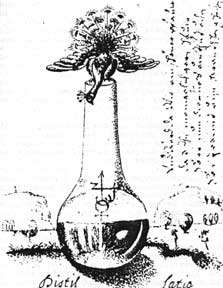
(18th century manuscript from the Collection
of Dr.C.Rusch, Appenzell)
The drawing represents Distillatio,
'distillation'. At a certain point in the distillation the peacock('s
tail) will appear.
The symbol of the peacock’s tail was chosen
because of the many colorful and brilliant ‘eyes’. It is said that
originally they were the eyes of the Greek Argus, whose name means ‘he
who sees everything’. Argus was a very strong giant with a hundred eyes,
of which at all times fifty were open and fifty were sleeping. He was
decapitated by Hermes. Hera, the mother goddess, placed the eyes on the
tail of her favorite bird, the peacock.
The phase of the many colors
was also symbolized by the rainbow, or the goddess of the rainbow: Iris,
the messenger of the gods, especially between Zeus and the mortals.
The peacock’s tail can have two meanings in the Great Work. It can be
the collection and totality of all colors in the white light. Remember,
the white light refers to the second stage, albedo, or whiteness. In
this sense the peacock was seen as a royal bird in ancient times, and it
corresponded with the phoenix.
The second meaning is that it
represents the failure of the alchemical process. When the conscious
enters the unconscious "each part of a thought can take shape and become
visible in color and form", according to a Chinese text about yoga
exercises. One starts seeing all kinds of forms which look real and
which look like they have an independent life. But one cannot go into it
as it leads to discord of the mind, and possibly to schizophrenia. The
alchemist is seeking unity, expressed in the white light.
It is know
that during meditation exalted feelings and unusual observations can
happen. In essence there are two kinds of observations. The first one is
wanting to escape the discipline of meditation, which Zen practitioners
call makyo. Makyo are illusions we project onto reality in order to
escape the guidelines of meditation. For example, the object of
meditation is starting to radiate with a wonderful light or color, or it
expands and contracts rhythmically. One starts to feel lighter or
heavier, or one feels pleasant energies going through the body. All
kinds of sensations can happen. Many meditators are readily distracted
by these phenomena, and even take great interest in them, thereby
neglecting the real purpose of their meditation. One needs to be aware
of this.
A second cause of distraction is a change in consciousness
whereby we look at the world in a different way than we did in the past.
It can be quite a shock reverberating on the psychic or bodily level.
The accompanying feelings can be quite wonderful. But the advice is:
enjoy it, do not take it seriously, and continue with the meditation.
Visions are also distracting. Many wise men and mystics have pointed to
this kind of danger. "We should not long for or expect visions. With all
our power we should refrain from them and look at them with suspicion."
(Ignatius of Loyola). They always stress that visions of lights, of
angels, yes even of the great masters, should be neglected, because they
block inner progress.
1.5 Albedo - Whiteness
Je ne
craignais pas de mourir
mais de mourir sans etre illumine.
(I was
not afraid to die,
but to die without having been enlightened)
Comte de Saint-Germain, La Tres Sainte Trinisophie
The herald of
the light
is the morning star.
This way man and woman approach
the dawn of knowledge,
because in it is the germ of life,
being a
blessing of the eternal.
Haji Ibrahim of Kerbala
Lucifer,
Lucifer stretch your tail,
and lead me away, full speed through the
narrow passage,
the valley of the death,
to the brilliant light,
the palace of the gods.
Isanatha Muni
Being deep in nigredo, a
white light appears. We have arrived at the second stage of the Great
Work: albedo, or whiteness. The alchemist has discovered within himself
the source from which his life comes forth. The fountain of life from
which the water of life flows forth giving eternal youth.
The source
is one: male and female are united. In alchemical images we see a
fountain from which two streams of water flow into one basin.
Albedo
is the discovery of the hermaphroditic nature of man. In the spiritual
sense each man is a hermaphrodite. We can also see this in the first
embryonic phase of the fetus. There is no sex until a certain number of
weeks after conception.
When man descended into the physical world
his body entered a world of duality. On the bodily level this is
expressed by the sexes. But his spirit is still androgen, it contains
duality in unity. Its unity is not bound to space, time or matter.
Duality is an expression of unity in our physical world. It is temporal
and will eventually cease to exist. When male and female are united
again, one will experience his true self. Conscious and unconscious are
totally united.
Albedo happens when the Sun rises at midnight. It is
a symbolic expression for the rising of the light at the depth of
darkness. It is the birth of Christ in the middle of the winter. In the
depth of a psychological crises, a positive change happens.
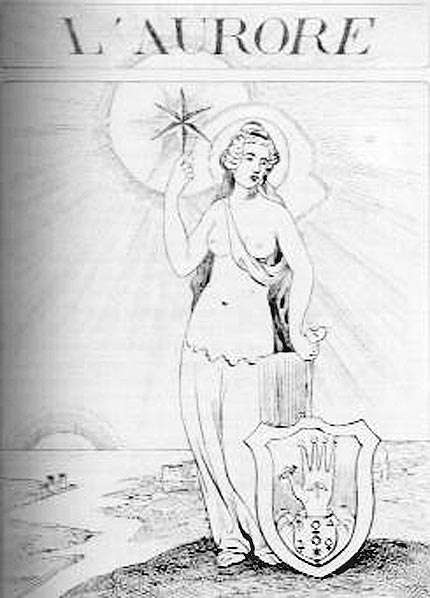
(L'Aurore, Henri de Linthaut)
Albedo, symbolized by Aurora, by the
dawn, the morning star (Venus-Aphrodite), and by the sun rising up from
the Philosopher's Sea.
Albedo is also represented by Aurora, the
Roman goddess of the dawn. Her brother is Helios, the Sun. With a play
of words aurora was connected with aurea hora, ‘the hour of gold’. It is
a supreme state of conscious. Pernety (1758): "When the Artist
(=Alchemist) sees the perfect whiteness, the Philosophers say that one
has to destroy the books, because they have become superfluous."
Albedo is also symbolized by the morning star Venus/Aphrodite. Venus has
a special place in the Great Work. In ancient times Lucifer was
identified with the planet Venus. Originally Lucifer has a very positive
meaning. In the Bible we find 2Petrus 1:19 "…till the day arrives and
the morning star rises in your hearts". In Revelation 12:16 Christ says:
"I am the shining morning star". Here Christ identifies himself with the
Lucifer! We find the same in mystic literature. In ancient times Lucifer
was a positive light being. It was just one man who changed all that:
when a certain Hieronymous read a phrase from Jesaja 14:12 (Jesaja
talking to a sinful king of Babylon): " How did you fall from heaven,
you morning star, you son of the dawn; how did you fall to earth,
conqueror of people". Hieronymous used this phrase to identify Lucifer
with the dragon thrown out of heaven by Michael. By the interpretation
of this one man, Lucifer was tuned from a shining light being into the
darkest devilish being in the world.
We find Lucifer in alchemy
associated with impure metals polluted by rough sulfur. It means that
the light being Lucifer in ourselves is polluted by what the alchemists
call ‘superfluities’, ‘dross’, caused by man himself.
Mercury and
Lucifer are one and the same. One talks about Mercury when he is pure,
it is the white sulphur, the fire in heaven. As ‘spiritus’ he gives
life. As ‘spiritus sapiens’ he teaches the alchemist the Great Work.
Lucifer is the impure Mercury. Lucifer is the morning star fallen from
(the golden) heaven. He descended into the earth and is now present in
all humans. Lucifer is Mercury mixed with impure elements. He dissolved
‘in sulfur and salt’, ‘is wrapped with strings’, ‘darkened with black
mud’. Keep in mind we are always talking about our consciousness.
Lucifer represents our everyday consciousness, all the (psychological
and other) complexes have clouded our pure consciousness, Mercury.
The light of Mercury that appears to us as Lucifer, because of the
distortion caused by the impurities, gives the impression of what the
alchemists called ‘red sulfur’. The red sulfur of Lucifer, as
traditional devil, is actually an illusion. It does not exist by itself
because it is only an image, a distorted image of Mercury. We ourselves
caused the impurities, the blackness that veils our true light being.
Red sulfur is the same as what is called Maya in eastern
philosophies. Maya is the world of illusions, or the veil that prevents
us from seeing and experiencing true reality, where the eternal light
is. By the impurities of Maya, man has become ignorant. He has forgotten
his origin and thinks he is in a world which in actuality is an
illusion.
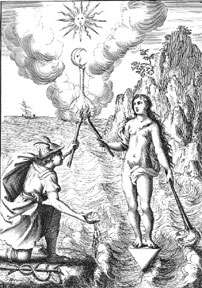
(Les Rudiments de la Philosophie, Nicolas de Losques,
Paris, 1665)
The union of Hermes and Aphrodite. The moon is above the
retort, indicating this is the stage of Albedo. The sun above is the
next stage of Rubedo. At the same time sun and moon are again the
opposites to be united. Aphrodite has two torches. One pointing down,
representing the lower passions to be transmuted. The upside down torch
is the purified energies. Aphrodite is standing on a tetrahedron, the
perfect three dimensional body, as all corners are equally distant from
each other, resulting in a lack of tension.
As we mentioned above,
Aphrodite/Venus as the morning star is a central image for the albedo
phase of the Great Work. Aphrodite was born from the foam that arose
when the genitals of Uranus (cut of by Chronos, out of hate and
jealousy) fell into the sea. The cutting of the genitals represents
repressed and tormented love. The sea, symbol of the soul, however will
bring forth the love goddess. Liberation will happen when we become
conscious again of the contents of the soul. As Aphrodite is born from
the sea, she is the guide through the fearful world of the unconscious
(the sea, or the underworld). The alchemist descends into these depths
to find the ‘prima materia’, also called the ‘green lion’. The color
green refers to the primal life forces. Venus also has the green color.
An important characteristic of Aphrodite is that she helps us in our
human shortcomings. She gives ideals and dreams to fulfill. But she also
gives frightening images in order to make man aware of his lower nature.
"By her beauty Venus attracts the imperfect metals and gives rise to
desire, and pushes them to perfection and ripeness." (Basilius
Valentinus, 1679) Liberation can only happen by becoming conscious of
the lower nature and how we transmute it.
In Jungian psychology
Venus/Aphrodite is the archetype of the anima (in alchemy also the
‘soror’ or ‘wife’ of the alchemist). The anima is the collective image
of the woman in a man. It is an image especially tainted by his first
contact with his mother. The anima represents all the female tendencies
in the psyche of a man, such as feelings, emotions, moods, intuition,
receptivity for the irrational, personal love and a feeling for nature.
She is the bearer for the spiritual. Depending on the development of the
man she can also be the seductress who lures him away to love,
hopelessness, demise, and even destruction.
Other alchemical images
for albedo are baptism and the white dove, both derived from
Christianity. Baptism symbolizes the purification of both body and soul
by ‘living water’. ‘Living water’ was regarded as the creative force of
the divine. It allowed the soul to be received into the community of the
holy spirit. Thus baptism allows the purified soul to bring forth the
resurrection of Christ in oneself. This is the ‘hieros gamos’, the
‘sacred marriage’ between the soul and Christ. Christ here represent our
own inner divine essence.
There are many other symbols in alchemy for
the second phase, or albedo: the white swan, the rose, the white queen,
and so on. As lead is the metal of nigredo, silver is the metal of
albedo, transmuted from lead. As silver is the metal of the moon, the
moon was also a symbol for albedo. Alchemists also talk about the white
stone or white tincture. They all means basically the same thing,
although one has to understand them in the context in which they were
written.
1.6 Rubedo -Redness
The alchemical process
is
a method for self knowledge
that the soul undergoes
far outside
its realm of existence.
Marry Anne Atwood
The jewel has been
lost in matter
and everybody is looking for it.
Some look for it
in the east
and some in the west,
some in water
and some among
stones.
But the servant Kabir
has found its value
and has it
wrapped with care
in the seam of the mantle of his heart.
R.
Tagore, Kabir 72
Albedo is a phase of which the meaning was
kept secret for many centuries. The meaning of the third alchemical
phase, rubedo or redness, is even more secret and not easy to explain or
understand.
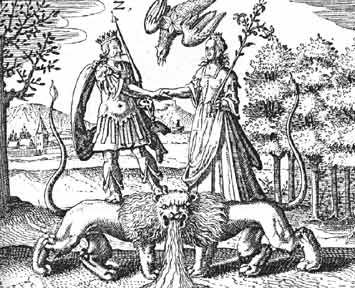
(Philosophia reformata, Johann Mylius, Frankfurt, 1622)
The union of the Red King with the White Queen, symbolic of the union of
male-female, albedo-rubedo. In other words, when after having attained
albedo (having discovered the divine light in oneself), the 'spirit'
must be fixated (the descending eagle), resulting in rubedo. The two
lions with one head signifies the unified nature that has been attained.
Out of its mouth flows the water of life.
Rubedo is the continuation
of albedo. That is why they are often seen connected to each other, like
the White Queen and the Red King. Once the inner light has been
discovered it must be made into the only reality in our consciousness.
After having descended into the unconscious, into the darkness, into the
underworld, we found the Light, we found the volatile Spirit. Now the
volatile Spirit, or quicksilver, has to be fixated or coagulated. This
means that our conscious, or attention, must completely penetrate our
unconscious, or soul, or everything that lies hidden in ourselves. By
doing this we fixate (that is bring it into the conscious) the volatile
and make it durable. When everything in ourselves has been purified and
the Light appears, we have to fixate this Light and make it durable so
it remains always present.
White sulfur, attained during albedo, is
also called: "the bodies composed of pure essence of the metals". The
metals are the contents of the soul, and now they have been reduced to
their pure essence. Now that the soul has been penetrated with the pure
light, the alchemist has to make it permanent.
In the eastern
philosophies rubedo corresponds with the formation of the ‘diamond
body’, an term fitting for the pure and permanent Stone of the
Philosophers.
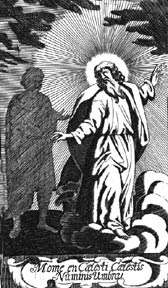
(Scritinium cinnabarium seu triga cinnabriorium,
Godfred Schulz, Halle, 1680)
The ressurected alchemist stepping from
the shadow into the Light.
In Christianity, rubedo corresponds with
the resurrection of Christ. Jesus ‘fixates’ the light garment of Christ.
Jesus has left behind the old body and brought his inner divine self,
the Christ body, into his consciousness, and made it his own reality.
What Jesus did two thousand years ago, each of us can do the same,
because we are all sons and daughters of the divine, and we all carry
the divine essence, or the Christ body, within ourselves.
When
rubedo has been realized the alchemist has accepted his spiritual
inheritance. He has become what he always has been, but never knew he
was. He has realized his divine essence while still in his physical
body. It is the same as what the gnostici called pneuma, the divine
spirit in each man that is concealed in the deep darkness of the world,
but can be made conscious again. When rubedo has been manifested man is
master over both the physical as the spiritual world. He has become a
King master over himself.
When the unification of all energies of
the four aspects of totality has been achieved, a new state of being
arises that is no longer subject to changes. Chinese alchemy calls it
the ‘diamond body’ which corresponds with the ‘corpus incorruptibile’
(untouchable body) of the European alchemy. It is also the same as the
‘corpus glorificationis’ (glorified body) of the Christian tradition.
In yoga traditions, rubedo corresponds with the unification of the
spirit of man, called atman, with brahman. Atman is a part of brahman.
Brahman is the soul of the All, it is the breath or the energy flowing
through you and giving you life and consciousness. Atman is the
individual self, brahman is the universel self.
"As the body used to
be slow, rough, impure, dark and destructible because it lacked power
and energy, so rebirth unifies it with the soul and spirit, vivified and
volatile, light and penetrating, pure, refined and clear, overflowing
with energy, indestructible and full of energy, and it is able to
maintain this." (Franciscus Kieser, +/_1600).
"Ascend above any
height, descend further than any depth; receive all sensory impressions
of the created: water, fire, dryness and wetness. Think that you are
present everywhere: in the sea, on earth and in heaven; think that you
were never born and that you are still in the embryonic state: young and
old, dead and in the hereafter. Understand everything at the same time:
time, place, things: quality and quantity." (Corpus hermeticum, 1460).
I feel that all stars
shine in me.
The world is breaking as
flood
through my life.
The flowers are opening in my body.
Youthfulness of earth and water
is burning like incense in my heart,
and the breath of all things
is playing as on a flute
through my
thoughts.